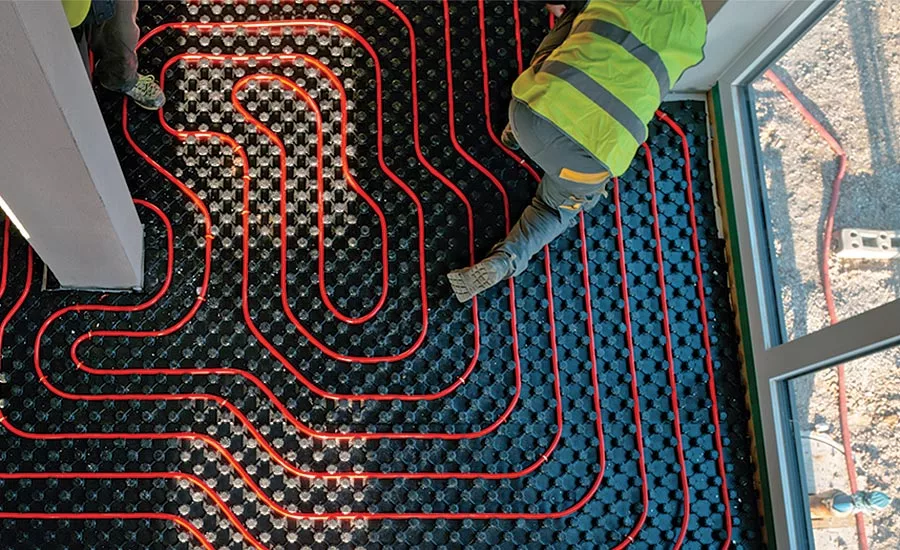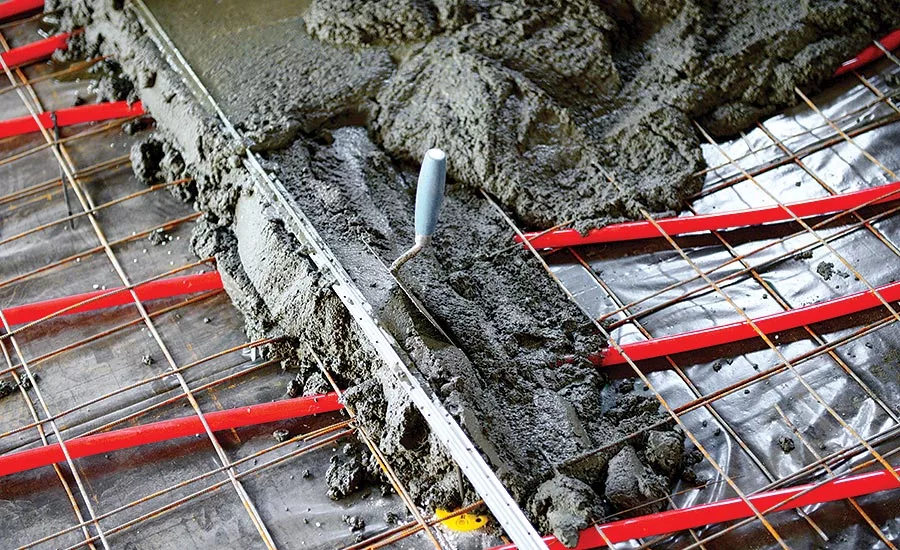Radiant Comfort Report
Multiple variables affect the operating costs of an HVAC system
Control of variables and choice are key to manage a mechanical system for the life of a building.

Hydronic systems, including radiant heating and cooling, provide optimum performance year-round. Sinenkiy/iStock / Getty Images Plus via Getty Images

A Hydronic central system takes control of the outside temperature swings, maintains system capability and eliminates the need for auxiliary systems or under the desk heaters. mumininan/E+ via Getty Images

Planning options for resilience and risk assessment are much easier due to the stability of a hydronic central system because of the availability of not only components, but service maintenance and repair. elenaleonova/iStock / Getty Images Plus via Getty Images
The energy used in your building is a function of multiple variables; the structure and occupancy for example. Other variables center around component selection, control and design. HVAC is not like buying a new laptop, outdated by the time you unbox. Technology is moving fast in HVAC as well, but the purchasing decision will be one that lasts for decades. A hydronic system advantage is that components are forward and backward compatible, enabling upgrade as technology and budgets allow, and ready replacement if required 20 years from now.
Hydronic systems are closed loop — simply meaning that water as the medium is recirculated — and it also means controlled; control of a variable. Your building HVAC system responds to the load inside the building and does so against the sources for heat absorption, heat rejection and the fuel sources outside the building. Or are they?
Advantage No. 1
The first major hydronic advantage is all the components in a water-based central system “work” against a “controlled loop temperature” to design conditions at optimum performance year-round. Utility bills and demand charges track outside temperatures and demand. Inside your building, load is also being affected by the outside temperature — hot or cold, heat wave or polar vortex — as well as the load that follows occupancy, lighting, machines and the dreaded “plug loads.” A Hydronic central system takes control of the outside temperature swings, maintains system capability and eliminates the need for auxiliary systems or under the desk heaters.
Advantage No. 2
Second, the central hydronic system has the capability of changing the operating temperature with anticipated demand, low energy function or setback/setup. A hydronic loop can operate at a deadband to net energy throughout the entire building or share energy among not only simultaneous or cyclical heating and cooling loads, but with hot water, and finally, instantaneously with only one compressor — or even no compressor — in operation.
HVAC readers know what a deadband is, however for the layperson, think of a water-source heat pump loop or even more simply think of your home thermostat — the degrees between “heat on” or “cool on” equals no energy consumed. That is the deadband — heat if below 68° F and cool if above 76° F, but not in the middle.
With water-source heat pumps or district ambient temperature loops, there will be a range where no new energy is required. Typical of a water-source heat pump that has a boiler when the loop gets too cold and a cooling tower when too hot, the range to best advantage is set, for example 60° low end and 90° on the high side. With geo designs, a loop is sized to never go below or above a design operating range, whatever is selected for the design, and to maintain not only capability to heat or cool but also maintain efficiency.
A four-pipe system with hot and cold circulating water — two loops — has a boiler that holds the temperature to a design of say 140° or 180°, and the boiler keeps it there. A floor might be at 105°, for example, and the boiler keeps it there: An example of changing the central loop to your advantage — less lift. An air handler or a fan coil in cooling needs 45° or to advantage higher or lower, but the chiller holds it there. And yes, it is possible that both the boiler and the chiller are running at the same time. Or are they in heat recovery mode? The drop from the boiler is called the ΔT and that is not a deadband, but that’s another topic.
So, the advantage with a heat pump is in the range where no energy is used, and the other is the simplicity of managing a central system to a range versus an exact temperature (think chilled beam) — and at no time does the system require both added heat and rejected heat. This is really what enables sharing of energy in the building when the interior zones heat the outdoor zones, or the example of cooling and water heating without buying new energy. Today’s water-source heat pumps can be a central system to multiple hydronic-based or ducted distribution systems, essentially reversing chillers with a very wide application range in both heating and cooling. There are multiple arrangements to include zoning and VAV applications that were not available when the only solution was horizontal units above the ceiling in every space. Rooftop and DOAS units, as well as water-to-water units, designed specifically for domestic water heating with double wall heat exchangers allow not only HVAC but water heating integration into simple but highly efficient solutions based on the owners requirements.
Advantage No. 3
Third is resilience. What makes a system resilient? It depends on the risk factors, which in today’s world, center around weather and extremes (climate change). Most hydronic components are inside the building, decreasing the effect of weather and minimizing the fear of theft. Planning options for resilience and risk assessment are much easier due to the stability of a hydronic central system because of the availability of not only components, but service maintenance and repair. Facility staff “know” the products and they can “Google it” readily if they do not. They include smart components, internet connected comfort alarms and early function alerts. Measurement and verification are also available online. Troubleshooting, if required, is simplified because you have control of variables.
Advantage No. 4
Finally, let’s talk return on investment, equipment life and flattening demand. Because all the components in a hydronic system function in a controlled environment, the first requirements for ROI are met due to two things: Increase life and maintenance of purchased performance. In the state of New York, heat pump systems can qualify for a special low rate because the demand is flat. However, if the system goes to backup heating, for example, the system is disqualified. Hydronic systems not only flatten the demand day but reduce all peaks. A discussion of adding renewables must address predictability. Renewables and HVAC system operation are critical for sizing, operation and financing the extra investment. Hydronic systems are easy to budget because more variables are controlled to design criteria.
Architects have control of the building, even present options to justify reduction in size of the HVAC system with facades, shading, insulation and lighting design all are variables.
Rule No. 1: Insulate your HVAC system from the effects of outdoor temperatures and take control of variables to your advantage for the life of the building.
Rule No. 2: Comfort distributed in water throughout the building is at 8% to 10% of the cost to move Btu in air or refrigerant.
Take pride in the knowledge that water has a global warming potential of zero, and that your system is not contributing to the “Urban Heat Island Effect.” By definition, you are being an energy steward, reducing energy use between 30% to 70% with a system that reduces both electrical consumption and fossil fuels onsite or from the source. High efficiency is achieved by component efficiency plus netting and recycling energy in the building before any new energy is purchased. Water is not wasted; it is circulated and provides for the ability to control cost for the life of your building.
Looking for a reprint of this article?
From high-res PDFs to custom plaques, order your copy today!






